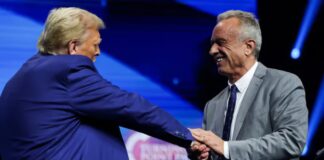Trump, like Homer, tends to pour fuel — and lots of it — on fires. Take the President’s handling of North Korea and its leader Kim Jong Un in the early days of his first term.
“I told Rex Tillerson, our wonderful Secretary of State, that he is wasting his time trying to negotiate with Little Rocket Man,” Trump tweeted in October 2017 in reference to North Korea’s aggressive pursuit of a nuclear program.
By January 2018, it looked as though Trump’s escalating rhetoric — just dumping lighter fluid on the fire — might lead to an actual war. “North Korean Leader Kim Jong Un just stated that the ‘Nuclear Button is on his desk at all times,'” Trump tweeted in January 2018. “Will someone from his depleted and food starved regime please inform him that I too have a Nuclear Button, but it is a much bigger & more powerful one than his, and my Button works!
Within six months of that tweet, Trump was sitting down with Kim in a historic summit between the two countries. The two men again huddled in February 2018. And, in mid-April of this year, Trump tweeted this: “I agree with Kim Jong Un of North Korea that our personal relationship remains very good, perhaps the term excellent would be even more accurate, and that a third Summit would be good in that we fully understand where we each stand.”
Trump, never one to let pass an opportunity to toot his own horn, took to Twitter to attack those who had questioned his methods: “A year ago the pundits & talking heads, people that couldn’t do the job before, were begging for conciliation and peace – ‘please meet, don’t go to war.’ Now that we meet and have a great relationship with Kim Jong Un, the same haters shout out, ‘you shouldn’t meet, do not meet!'”
And, even those who had fretted that Trump might be tweeting us into a war grudgingly admitted that he had, somehow, pulled the US from the brink with North Korea. While specifics of any long-term deal with North Korea to end its pursuit of nuclear weapons remained elusive, the fact that the country hadn’t tested any long-range missiles since talks began was seen as a sign of the success of Trump’s approach. By one-upping a one-upper, Trump had won the game of chicken — forcing Kim to blink.
Until, that is, an image obtained by CNN over the weekend seemed to suggest that North Korea had tested a short-range missile on Friday. CNN’s Zachary Cohen and Nicole Gaouette wrote:
“The missile test, North Korea’s first since 2017, serves as a clear warning of leader Kim Jong Un’s frustration at the state of talks with the US, which have been deadlocked since President Donald Trump walked out of their Vietnam summit early in February.”
Whether or not Trump’s fuel-to-the-fire approach is in the process of failing in North Korea, the President is in the process of utilizing the exact same methods in other notable hot spots around the world.
On Sunday night, national security adviser John Bolton announced that the U.S. was moving a carrier fleet and a bomb strike force to the Middle East as a deterrent for possible Iranian military action. The moves were designed “to send a clear and unmistakable message to the Iranian regime that any attack on United States interests or on those of our allies will be met with unrelenting force,” said Bolton in a statement announcing the move. According to CNN’s Barbara Starr: “‘Specific and credible’ intelligence that suggested Iranian forces and proxies were targeting US forces in Syria, Iraq and at sea led the Pentagon to recommend a carrier strike group be moved to the region, two US officials tell CNN.”
Amid renewed fighting between Palestinians in Gaza and the Israelis, Trump took to Twitter Sunday night to put the clear burden on the Palestinians to bring about peace:
“Once again, Israel faces a barrage of deadly rocket attacks by terrorist groups Hamas and Islamic Jihad. We support Israel 100% in its defense of its citizens. To the Gazan people — these terrorist acts against Israel will bring you nothing but more misery. END the violence and work towards peace – it can happen!”
Trump threatened to escalate the ongoing trade war between the U.S. and China during a tweetstorm on Sunday. Trump Tweeted:
“For 10 months, China has been paying Tariffs to the USA of 25% on 50 Billion Dollars of High Tech, and 10% on 200 Billion Dollars of other goods. These payments are partially responsible for our great economic results. The 10% will go up to 25% on Friday. 325 Billions Dollars of additional goods sent to us by China remain untaxed, but will be shortly, at a rate of 25%. The Tariffs paid to the USA have had little impact on product cost, mostly borne by China. The Trade Deal with China continues, but too slowly, as they attempt to renegotiate. No!“
Those tweets — and the possibility of a worsening trade war between the two superpowers — led to significant worry on Wall Street. The Dow was off nearly 200 points as of 2 p.m. eastern.
Trump, in only the 2nd veto of his presidency last month, rejected a resolution passed through Congress that would have aimed to end American involvement in the Saudi-led war in Yemen. The Congressional resolution was seen as an attempt by lawmakers — in both parties — to rebuke Trump for his tolerance of Saudi Arabia’s involvement in the murder of journalist Jamal Khashoggi.
In each situation, Trump stoked the fires rather than seeking to dowse them — under the belief, as demonstrated with North Korea earlier in his presidency, that only by calling bluffs and exerting heavy pressure can change and realignment occur. Like much of what Trump does, it’s a risky strategy with clear and dangerous downsides if it fails.
Views: 322
















